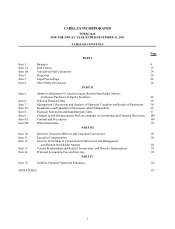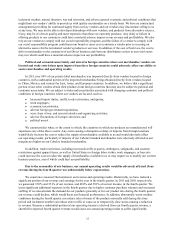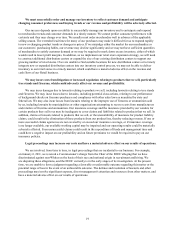Cabela's 2011 Annual Report Download - page 20
Download and view the complete annual report
Please find page 20 of the 2011 Cabela's annual report below. You can navigate through the pages in the report by either clicking on the pages listed below, or by using the keyword search tool below to find specific information within the annual report.10
Employees
At the end of 2011, we employed 14,800 employees - 6,700 of whom were employed full-time. We use
part-time and temporary workers to supplement our labor force at peak times during our third and fourth quarters.
None of our employees are represented by a labor union or are party to a collective bargaining agreement. We have
not experienced any work stoppages and consider our relationship with our employees to be good.
Seasonality
We experience seasonal fluctuations in our revenue and operating results. Due to buying patterns around the
holidays and the opening of hunting seasons, our merchandise revenue is traditionally higher in the third and fourth
quarters than in the first and second quarters, and we typically earn a disproportionate share of our operating
income in the fourth quarter. Because of our retail store expansion, and fixed costs associated with retail stores, our
quarterly operating income may be further impacted by these seasonal fluctuations. We anticipate our sales will
continue to be seasonal in nature. Refer to Note 26 to our consolidated financial statements for quarterly results of
operations for 2011 and 2010.
Government Regulation
Regulation of World’s Foremost Bank. WFB, our wholly-owned bank subsidiary, is a Nebraska state-
chartered bank with deposits insured by the Bank Insurance Fund of the FDIC. WFB is subject to comprehensive
regulation and periodic examination by the Nebraska Department of Banking and Finance and the FDIC. WFB
does not qualify as a “bank” under the Bank Holding Company Act of 1956, as amended, (“BHCA”), because it
is in compliance with a credit card bank exception from the BHCA. On July 21, 2010, the Reform Act was signed
into law. The Reform Act has made extensive changes to the laws regulating financial services firms and credit
rating agencies and requires significant rule-making. In addition, the legislation mandates multiple studies which
could result in additional legislative or regulatory action. The Reform Act does not eliminate the exception from
the definition of “bank” under the BHCA for credit card banks, such as WFB. However, as directed by the Reform
Act, the United States Government Accountability Office released a report on January 20, 2012, that examines
the potential implications of eliminating certain exceptions under the BHCA, including the exception for credit
card banks. It is unclear whether this report will lead to any additional legislative or regulatory action. If the credit
card bank exception were eliminated or modified, we may be required to divest our ownership of WFB unless we
were willing and able to become a bank holding company under the BHCA. Any such forced divestiture would
materially adversely affect our business and results of operations. In addition, the Reform Act establishes a new
independent Consumer Financial Protection Bureau (the “Bureau”) which will have broad rulemaking, supervisory,
and enforcement authority over consumer products, including credit cards. The Reform Act will also affect a
number of significant changes relating to asset-backed securities, including additional oversight and regulation of
credit rating agencies and additional reporting and disclosure requirements. See “Risk Factors - The Dodd-Frank
Wall Street Reform and Consumer Protection Act may impact the practices of our Financial Services business and
could have a material adverse effect on our results of operations” and “Management’s Discussion and Analysis of
Financial Condition and Results of Operations - Developments in Legislation and Regulation.”
There are various federal and Nebraska laws and regulations relating to minimum regulatory capital
requirements and requirements concerning the payment of dividends from net profits or surplus, restrictions
governing transactions between an insured depository institution and its affiliates, and general federal and Nebraska
regulatory oversight to prevent unsafe or unsound practices. At the end of 2011, WFB met the requirements for a
“well-capitalized” institution, the highest of the Federal Deposit Insurance Corporation Improvement Act’s five
capital ratio levels. A “well-capitalized” classification should not necessarily be viewed as describing the condition
or future prospects of a depository institution, including WFB. In addition, as of December 31, 2011, the most recent
notification from the FDIC categorized WFB as “well-capitalized” under the regulatory framework for prompt
corrective action. We may be required to invest additional capital in WFB for WFB to remain “well-capitalized.” See
“Risk Factors - We may have to reallocate capital from our Retail and Direct businesses to meet the capital needs of
our Financial Services business, which could alter our retail store expansion program.”
























